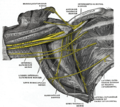| Subclavius muscle | |
|---|---|
 Subclavius muscle (shown in red). | |
 Deep muscles of the chest and front of the arm, with the boundaries of the axilla. (Subclavius visible at upper left, above first rib.) | |
| Details | |
| Origin | First rib and cartilage |
| Insertion | Subclavian groove of clavicle (inferior surface of middle one third of the clavicle) |
| Artery | Thoracoacromial trunk, clavicular branch |
| Nerve | Subclavian nerve |
| Actions | Depression of clavicle elevation of first rib |
| Identifiers | |
| Latin | musculus subclavius |
| TA98 | A04.4.01.007 |
| TA2 | 2306 |
| FMA | 13410 |
| Anatomical terms of muscle | |
The subclavius is a small triangular muscle, placed between the clavicle and the first rib. [1] Along with the pectoralis major and pectoralis minor muscles, the subclavius muscle makes up the anterior axioappendicular muscles, also known as anterior wall of the axilla. [2]







